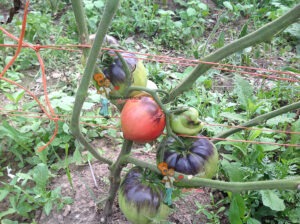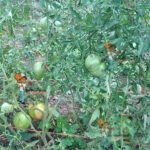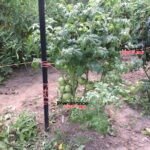Pruning Heirloom Tomato Plants
To prune or not to prune, that is the question! I have heard many different versions of how to, or even if tomato plants should be pruned. Are there advantages to pruning heirloom tomato plants? In my experience there definitely are! But how much pruning is too much? In this article I will discuss some of the methods that I have used and what what has worked best for me.
Heavily Pruning Tomato Plants
Some excellent gardeners believe that heavily pruning a tomato plant is the best way to go. They cut and pluck, nip and tuck until they are down to just two main stems. Everything below those two stems is cleaned out! It may be their belief and perhaps testimony, that this method produces the best results for them. I believe that there are definite advantages to pruning this way, but I also believe that there are some disadvantages. Heavy pruning certainly encourages maximum air flow and perhaps less diseases, but for someone like me who’s looking for bigger crop size for market sales and extensive seed saving, it’s not the best solution for me.
Another issue that arises from heavy pruning is sun scald on the fruits. Because there may be insufficient leaves to to protect the fruits, they may have extended periods of direct exposure to the sunlight during the hottest parts of the growing season. This usually results in sun scalding and consequently, lost fruits. This kind of heavy pruning may work best for indoor growing environments such as in greenhouse where the plants do not have direct sunlight exposure.
No Pruning Please.
 When I first started growing heirloom tomatoes I never pruned my plants. In fact, it cut me to the core each time I removed even one healthy leaf. Now, I know that pruning a tomato plant is actually helping the plant survive and is absolutely necessary! Still, many experienced growers choose not to prune. Their belief is that tomato plants need all of their leaves to best ripen and protect their fruits. I could easily be in this boat, but the reality is that every garden I have pruned produce immensely better results than the ones that I did not. The main reason for this is that I was always fighting diseases in my un-pruned gardens. So how do I achieve the best of both worlds?
When I first started growing heirloom tomatoes I never pruned my plants. In fact, it cut me to the core each time I removed even one healthy leaf. Now, I know that pruning a tomato plant is actually helping the plant survive and is absolutely necessary! Still, many experienced growers choose not to prune. Their belief is that tomato plants need all of their leaves to best ripen and protect their fruits. I could easily be in this boat, but the reality is that every garden I have pruned produce immensely better results than the ones that I did not. The main reason for this is that I was always fighting diseases in my un-pruned gardens. So how do I achieve the best of both worlds?
Finding The Middle Ground When Pruning Tomato Plants.
When it comes to realizing big crops and effective disease management, I have most effectively found the middle ground between pruning and not. Naturally, the perfect solution would be pruning just as much as needed. That’s exactly what I do! I start pruning the very bottoms when the plant has about four healthy and well established vines. From that point, I prune any new sucker that is too close to the ground or causing clutter. I always try to keep more than four strands on my plants, as long as they are above the cut off point. I also cut off any leaf that is too close to the ground if it’s difficult to manage and posing threat to the plant. All it takes is one leaf and the entire plant could be diseased in just a few weeks.
My aim is always to have the bottom-most 12-15 inches, or so, clean! Once the very bottoms are cleaned, from that point I manage as needed. I may eventually work my way a little higher up the vine, but not all at once! Usually, I end up with 5 or more strands, all of which produce healthy fruits. This method also insures that there is enough foliage to protect the fruits. Along with effective staking and timely fungicide treatment, pruning as necessary is easily my choice! Just a quick note. Pruning heirloom tomato plants that are determinate, is not necessary!
- Regular Leaf Dwarf Tomato Plant








